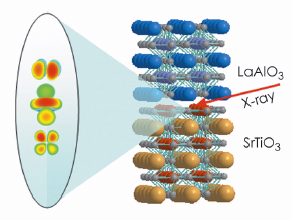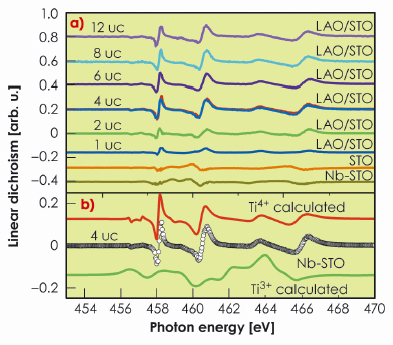- Home
- Users & Science
- Scientific Documentation
- ESRF Highlights
- ESRF Highlights 2009
- Electronic structure and magnetism
- Orbital reconstruction and a 2D electron gas at the interface between insulating transition metal oxides
Orbital reconstruction and a 2D electron gas at the interface between insulating transition metal oxides
In 2004, Ohtomo and Hwang discovered that an electron gas can be generated at the LaAlO3/SrTiO3 (LAO/STO) interface, i.e. by combining two insulating transition metal oxides [1]. High carrier mobility [1], electric field tuneable superconductivity [2] and magnetic effects [3], have been found in this system. Very interestingly, the conductivity of this interface is obtained only when specific conditions are met, and in particular when an atomic layer of LaO, belonging to the LaAlO3, is deposited on top of a TiO2-terminated STO single crystal, thereby realising an n-type interface doped with electrons. Additionally, it has been shown that LAO/STO bilayers only generate a conducting interface if the thickness of the LAO film reaches a critical value of 4 unit cells [4]. This behaviour is consistent with the so-called “polarisation catastrophe” mechanism, which attributes the induction of carriers at the interface to the large electrostatic potential of the charged AlO2– and LaO+ layers. However, this remains a subject of debate; other hypotheses have been considered, including the possible induction of a metallic state in the STO layers associated with stoichiometric defects, like oxygen vacancies and cationic substitution.
To clarify this issue we have used X-ray absorption spectroscopy (XAS) at the titanium L2,3 edge to study the unoccupied 3d states of the STO layers close to the interface. The experiments were performed at beamline ID08. The LAO/STO heterostructures were grown by pulsed laser deposition. We have compared results from samples grown in Augsburg [4] and Geneva [2], showing low temperature superconductivity, and samples grown in Twente [3] exhibiting magnetic effects. In order to have interface sensitivity we took measurements using the total electron yield (TEY) technique, characterised by a probe depth between 2 and 4 nm, at incidence angles varying from 90° (normal to the interface) to 20° (grazing).
The XAS process is strongly influenced by the splitting of the 3d levels and therefore provides information on the crystal field. By using linearly polarised light, it is possible to select an in-plane (dxy, dx2-y2) or an out-of-plane (dxz, dyz, and dz2) orbital as final state and measure the linear dichroism (LD), which is the difference between XAS spectra with out-of-plane (Ic) and in-plane polarisation (Iqb) (Figure 85).
 |
|
Fig. 85: a) Schematic diagram of the XAS and LD experiment illustrating the main concept used to study the orbital anisotropy of the 3d Ti states at the LAO/STO interface. |
The key results are shown in Figures 86a and 86b, where the LD spectra are plotted as a function of the number of LAO layers and compared to ion scattering calculations. Bare, TiO2 terminated, undoped and Nb-doped, STO are characterised by a small dichroism, due to the abrupt truncation of the surface. The linear dichroism spectra is well reproduced by a small positive splitting of 40 meV between in-plane (dxy, dx2-y2) and out-of-plane (dxz, dyz, and dz2) states of the Ti4+ ions. By depositing only one LAO unit cell on the top of a TiO2 terminated STO, the dichroism changes sign, but it remains small. Very strikingly, the linear dichroism becomes pronounced only above 4 u.c, when the interface becomes conducting, and then it remains constant up to a LAO thickness of 12 unit cells. This result has to be associated to an abrupt change of the anisotropy in the 3d electronic states, and therefore to an orbital reconstruction of the interfaces, which removes the 3d degeneracy completely. Nevertheless, the orbital reconstruction is not attributed to the transfer of electrons to the in plane 3dxy states, which in case of localisation would change the valency of a fraction of Ti4+ ions to Ti3+. Rather, the linear dichroism is perfectly reproduced by assuming a splitting between in plane and out-of -plane 3d states of Ti4+ ions of 60 meV and 100 meV for t2g and eg states respectively (Figure 86b).
 |
|
Fig. 86: a) Experimental linear dichroism (Ic-Iab) as a function of the number of LAO layers; b) Comparison between multiplet calculations for anisotropic Ti4+ (red line) and Ti3+ (green line) 3d states and the data acquired on a 4 unit cell (uc) LAO/STO (open circles). |
These results demonstrate that the realisation of a conducting interface is correlated to an orbital reconstruction of the Ti 3d states. This reconstruction pushes the 3dxy orbitals to lower energy and electrons can be transferred to the interface mainly to these 3dxy states, without occupying localised states. This also explains why the linear dichroism does not have a contribution from Ti3+ states.
References
[1] A. Ohtomo and H.Y. Hwang, Nature 427, 423 (2004).
[2] N. Reyren et al., Science 317, 1196 (2007).
[3] A. Brinkman et al., Nature Mater. 6, 493 (2007).
[4] S. Thiel et al., Science 313, 1942 (2006).
Principal publication and authors
M. Salluzzo (a), J.C. Cezar (b), N.B. Brookes (b), V. Bisogni (b), G.M. De Luca (a), C. Richter (c), S. Thiel (c), J. Mannhart (c), M. Huijben (d), A. Brinkman (d), G. Rijnders (d), and G. Ghiringhelli (e), Phys. Rev. Lett. 102, 166804 (2009).
(a) CNR-INFM COHERENTIA, Napoli (Italy)
(b) ESRF
(c) University of Augsburg (Germany)
(d) MESA+ Institute for Nanotechnology, University of Twente (The Netherlands)
(e) CNR-INFM Coherentia and Dipartimento di Fisica, Politecnico di Milano (Italy)



